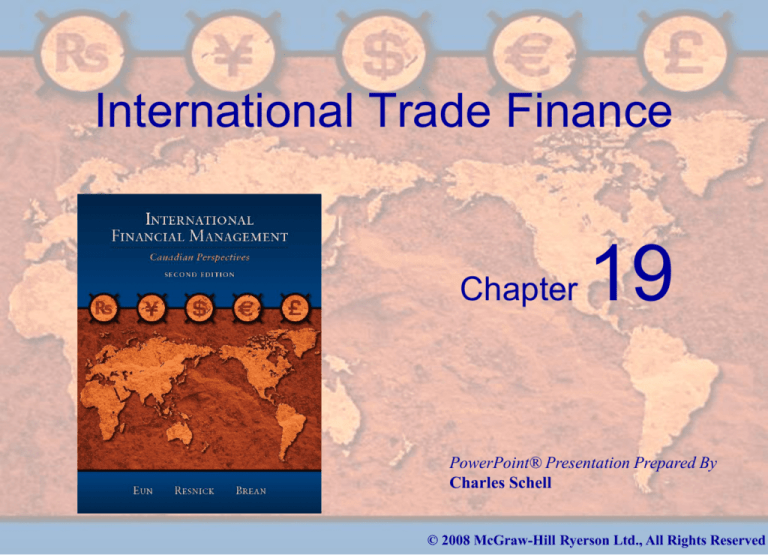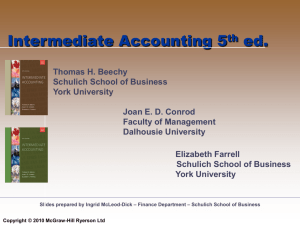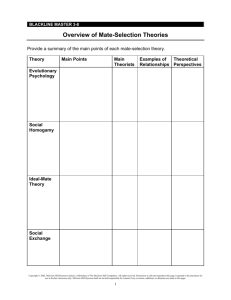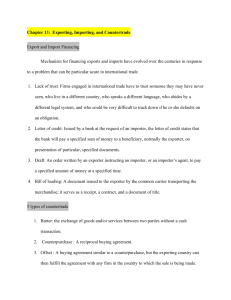
International Trade Finance
Chapter
19
PowerPoint® Presentation Prepared By
Charles Schell
© 2008 McGraw-Hill Ryerson Ltd., All Rights Reserved
Chapter Outline
A Typical Foreign Exchange Transaction
Export Finance
Government Assistance in Exporting
The Export-Import Bank and Affiliated Organizations
Intra-Firm International Trade
Countertrade
Slide 19-1
Forms of Countertrade
Generalizations about Countertrade
© 2008 McGraw-Hill Ryerson Ltd., All Rights Reserved
19.1 A Typical Foreign Exchange
Transaction
Over the years, (centuries, really) an elaborate
process has evolved for handling exports and
imports.
Figure 19.1 illustrates this process
Slide 19-2
© 2008 McGraw-Hill Ryerson Ltd., All Rights Reserved
Process of a Typical Foreign
Trade Transaction
1
Importer
Purchase order
5
Exporter
Shipment of
goods
Money
Market
Investor
B/A
12
2
10 11 14
13
16
3
7
Importer’s Bank
8
Slide 19-3
15
B/A presented at
maturity
Letter of Credit
4
6
9
Shipping Documents and
time draft accepted
Exporter’s
Bank
Payment-discounted value of B/A
© 2008 McGraw-Hill Ryerson Ltd., All Rights Reserved
Letter of Credit
A guarantee from the importer’s bank that it will
act on behalf of the importer and pay the exporter
for the merchandise if all relevant documents
specified in the letter of credit are presented
according to the terms of the letter of credit.
Slide 19-4
In essence the importer’s bank is substituting its
creditworthiness for that of the importer.
© 2008 McGraw-Hill Ryerson Ltd., All Rights Reserved
Time Draft
A written order instructing the importer or his
agent, the importer’s bank, to pay the amount
specified on its face on a certain date.
Slide 19-5
© 2008 McGraw-Hill Ryerson Ltd., All Rights Reserved
Bill of Lading
A document issued by the common carrier
specifying that it has received the goods for
shipment; it can serve as title for the goods.
Slide 19-6
© 2008 McGraw-Hill Ryerson Ltd., All Rights Reserved
Banker’s Acceptances
The exporter’s bank presents the shipping
documents and the time draft to the importer’s
bank.
After taking title to the goods via the bill of
lading, the importer’s bank accepts the time draft.
At this point the banker’s acceptance is created.
Slide 19-7
It is a negotiable money market instrument.
A secondary market exists for banker’s acceptances.
© 2008 McGraw-Hill Ryerson Ltd., All Rights Reserved
Banker’s Acceptances
Banker’s acceptances can be held to maturity by
the exporter.
The exporter can also sell it (at a discount) in the
money market.
Since the risks are similar, B/As trade at rates
comparable to certificates of deposit.
Slide 19-8
© 2008 McGraw-Hill Ryerson Ltd., All Rights Reserved
19.2 Export Finance
Buyer Credits
Supplier Credits
Direct loans
Allocations under lines of credit
Note purchase agreements
Forfaiting: applies to promissory notes (similar to
factoring of accounts receivable)
Slide 19-9
© 2008 McGraw-Hill Ryerson Ltd., All Rights Reserved
Forfaiting
Forfaiting is a type of medium-term financing
used to finance the sale of capital goods.
It involves the sale of promissory notes signed by
the importer in favour of the exporter.
The forfait, usually a bank, buys the notes at a
discount from face value from the exporter.
The exporter gets paid and does not have to carry
the financing.
Slide 19-10
© 2008 McGraw-Hill Ryerson Ltd., All Rights Reserved
19.3 Government Assistance in
Exporting
For political reasons (having to do with
mercantilism) most developed countries offer
competitive assistance to domestic exporters.
This assistance often takes the form of subsidized
credit that can be extended to exporters.
Also credit insurance programs that guarantee
financing extended by private financial
institutions are common.
Slide 19-11
© 2008 McGraw-Hill Ryerson Ltd., All Rights Reserved
The Export-Import Bank and
Affiliated Organizations
In 1934 the Eximbank of the United States was
founded as an independent government agency to
facilitate and finance U.S. export trade.
Export Development Canada provides Exim bank
services in Canada www.edc.ca
Export Guarantee Program
Note purchases
Lines of credit
Factoring
Security compliance loans
Bank guarantee program
Commercial Interest Reference Rates (CIRRs)
Slide 19-12
© 2008 McGraw-Hill Ryerson Ltd., All Rights Reserved
The Export-Import Bank and
Affiliated Organizations
An EXIM bank’s purpose is to provide
financing in situations where private financial
institutions are unable or unwilling to because:
Slide 19-13
The loan maturity is too long.
The amount of the loan is too large.
The loan risk is too great.
The importing firm has difficulty in obtaining hard
currency.
© 2008 McGraw-Hill Ryerson Ltd., All Rights Reserved
19.4 Intra-Firm International Trade
A large and growing part of international trade
flows across borders but within firms.
The North American automotive industry is a good
example.
Linked to foreign direct investment.
Slide 19-14
© 2008 McGraw-Hill Ryerson Ltd., All Rights Reserved
19.5 Countertrade
Countertrade is an umbrella term used to describe
many different types of transactions each in
“which the seller provides a buyer with goods or
services and promises in return to purchase goods
or services from the buyer”.
Countertrade may or may not involve the use of
currency, as in barter.
Slide 19-15
© 2008 McGraw-Hill Ryerson Ltd., All Rights Reserved
Forms of Countertrade
Barter
The direct exchange of goods between traders. Barter
requires a double coincidence of wants.
A buy-back transaction involves a technology
transfer via the sale of a manufacturing plant.
Slide 19-16
The seller of the plant agrees to buy back some of the
output of the plant once it is constructed.
© 2008 McGraw-Hill Ryerson Ltd., All Rights Reserved
Forms of Countertrade
A counterpurchase trade agreement is similar to a
buy-back transaction, but differs in that
The output that the seller of the plant agrees to buy is
unrelated to the plant.
An offset transaction can be viewed as a
counterpurchase trade agreement involving the
aerospace/defense industry.
Slide 19-17
© 2008 McGraw-Hill Ryerson Ltd., All Rights Reserved
Disadvantages of Countertrade
It is inefficient.
Some claim that such transactions tamper with the
fundamental operation of free markets, and
therefore resources will be used inefficiently.
Transactions that do not make use of money
represent a huge step backwards in economic
development.
Slide 19-18
© 2008 McGraw-Hill Ryerson Ltd., All Rights Reserved
Advantages of Countertrade
Countertrade conserves cash and hard currency.
Advantages also include the improvement of trade
imbalances, the maintenance of export prices,
enhanced economic development, increased
employment, technology transfer, market
expansion, increased profitability, less costly
sourcing of supply reduction of surplus goods
from inventory, and the development of marketing
expertise.
Slide 19-19
© 2008 McGraw-Hill Ryerson Ltd., All Rights Reserved
Generalizations about
Countertrade
There are advantages and disadvantages
associated with countertrade.
It can benefit both parties and in some
circumstances is the only trade possible.
Whether countertrade transactions are good or bad
for the global economy, it appears certain that
they will increase in the near future as world trade
increases.
Slide 19-20
© 2008 McGraw-Hill Ryerson Ltd., All Rights Reserved
Summary
International trade is more complex and riskier than
domestic trade;
A typical foreign trade transaction requires three basic
documents:
Letter of credit;
Time draft –can be converted into a banker’s acceptance;
Bill of lading.
Forfaiting involves a bank purchasing a series of promissory
notes in favour of an exporter at a discount;
EDC provides assistance to exporters through direct loans,
loan guarantees and credit insurance;
Countertrade transactions typically involve a reciprocal
promise in exchange for goods and/or services.
Slide 19-21
© 2008 McGraw-Hill Ryerson Ltd., All Rights Reserved




